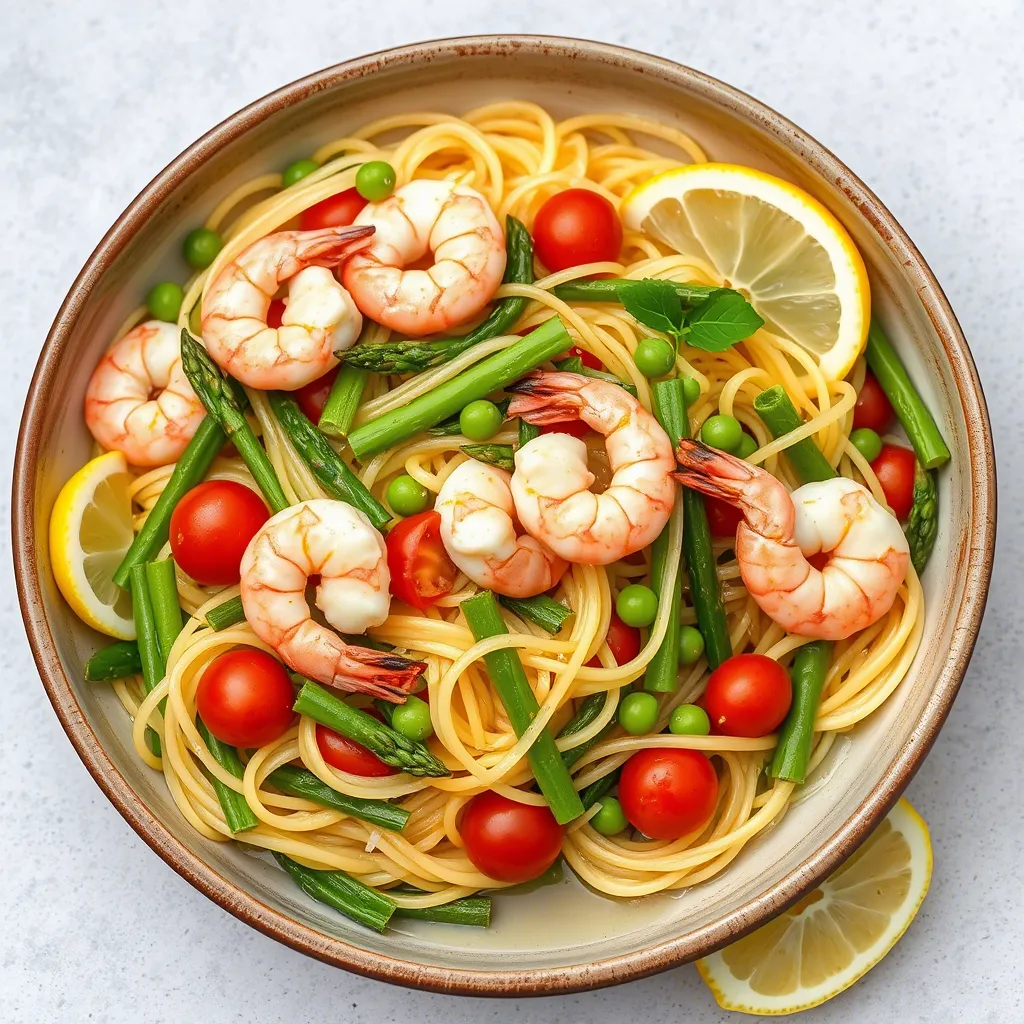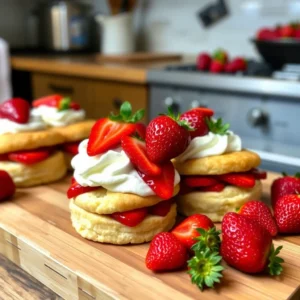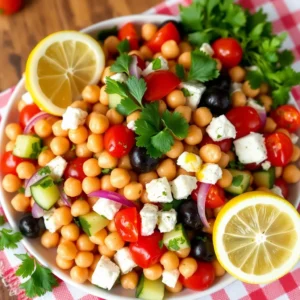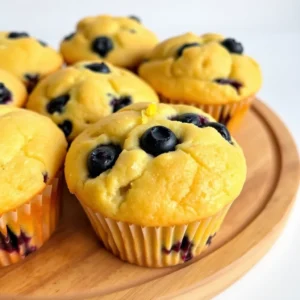Why You’ll Love This Lemon Garlic Shrimp
There’s something magical about the combination of zesty lemon, aromatic garlic, and succulent shrimp that makes this garlic shrimp pasta an absolute showstopper on your dinner table. As a busy mom of three, I understand the daily dinner dilemma all too well—you want something impressive enough to make everyone’s eyes light up, but quick enough that you’re not spending hours in the kitchen when you could be helping with homework or simply putting your feet up after a long day.
This lemon garlic shrimp with spring vegetables is my secret weapon for those evenings when I want to feel like a culinary hero without the superhuman effort. In just 30 minutes (yes, I timed it!), you’ll transform simple ingredients into a restaurant-worthy meal that will have your family thinking you’ve been hiding professional chef skills all along.
What makes this dish truly special is how the bright, citrusy notes of lemon perfectly balance the rich, buttery garlic sauce, while the tender-crisp spring vegetables add both color and nutrition. It’s the kind of meal that makes your kitchen smell so incredible that family members will mysteriously appear, asking “When’s dinner ready?” while trying to sneak a taste.
The beauty of this garlic shrimp pasta lies in its versatility. Having a gluten-sensitive guest? Swap in your favorite gluten-free pasta. Need to stretch the meal further? Add an extra handful of vegetables. Cooking for someone who claims they “don’t like seafood”? I’ve yet to meet the person who didn’t change their mind after trying this dish—the flavors are just that harmonious.
For busy weeknights, you can even prep components ahead of time (I’ll share that secret later), making the actual cooking process even quicker. The result is a meal that feels special enough for company but simple enough for a Wednesday night when your energy reserves are running low and the takeout menu is calling your name.
I particularly love how this dish brings together protein, carbs, and vegetables in one beautiful, cohesive meal—no need to worry about preparing separate side dishes when everything your family needs is twirled right onto their forks. And while we’re on the subject of nutrition, this lemon seafood creation delivers impressive protein from the shrimp while keeping the overall dish light and fresh—perfect for those spring and summer evenings when you want something satisfying but not heavy.
If you’ve been stuck in a dinner rut, cycling through the same tired recipes week after week, this lemon garlic shrimp pasta is your ticket to culinary excitement without complexity. It’s the kind of recipe that reminds us that delicious food doesn’t need to be complicated—sometimes the most memorable meals come from simple ingredients treated with a little love and attention.
The Story Behind This Lemon Garlic Shrimp
This lemon garlic shrimp with spring vegetable pasta has become something of a legend in my household, and its origin story makes me smile every time I prepare it. It all began during a particularly chaotic period when my youngest was starting kindergarten, my middle child had just discovered competitive soccer, and my oldest was navigating the social complexities of middle school. Our family calendar looked like an abstract expressionist painting—colorful, busy, and completely incomprehensible to the untrained eye.
During this whirlwind season, my mother-in-law came to visit, bringing with her a cookbook from her favorite Italian restaurant back home. While flipping through the pages, we discovered a complicated seafood pasta that looked divine but required about 27 ingredients and nearly two hours of preparation. “Who has time for that?” she laughed, and in that moment, a challenge was born. Could we create something equally delicious but significantly simpler?
We raided my pantry and refrigerator, finding some shrimp in the freezer, lemons in the fruit bowl, and the first spring vegetables from our weekly farmers market haul. With a glass of wine in hand and my mother-in-law’s stories filling the kitchen, we experimented, tasted, adjusted, and laughed our way to what would become this family favorite.
The first time I served it to my children, I expected the usual negotiations and bribes that often accompany introducing a new dish. Instead, my usually picky middle child took one bite and declared, “Mom, this is what I want for my birthday dinner!” My husband, who typically approaches seafood with the caution one might reserve for disarming explosives, actually went back for seconds. Even my teenager, whose primary form of communication had devolved to shrugs and grunts, managed an enthusiastic “This is actually good!”
If you’ve ever explored the delights of tomato burrata salad, you know how simple, quality ingredients can create something greater than the sum of their parts. This pasta follows the same philosophy—straightforward components that come together in harmony.
Now, this lemon garlic shrimp pasta has become our family’s celebration dish. We’ve enjoyed it on last days of school, after soccer championships (both victories and defeats—because sometimes you need comfort food most when things don’t go as planned), and on random Tuesdays when life feels particularly challenging and we need a reminder of our capacity for creating small moments of joy.
What I love most about sharing this recipe is knowing it might become part of your family’s story too. Perhaps you’ll make it for a date night at home when going out feels like too much effort. Maybe it will become your go-to impressive-but-easy dish for last-minute dinner guests. Or perhaps, like in our home, it will simply be the meal that brings everyone to the table with genuine enthusiasm, creating a brief pause in our busy lives where we connect over good food and conversation.
Every time I prepare this dish, I’m transported back to that afternoon in the kitchen with my mother-in-law, reminded that some of life’s best creations come from necessity, creativity, and a willingness to experiment. And isn’t that what home cooking is all about?
Let’s gather everything you’ll need for this garlic shrimp pasta masterpiece! The beauty of this recipe lies in its straightforward ingredient list—things you might already have in your kitchen or can easily find with one quick trip to the grocery store.
For the star of our show—the shrimp—you’ll need 1 pound of large shrimp (21-25 count per pound works perfectly). I recommend buying them already peeled and deveined to save yourself some prep time, but if you find a great deal on shell-on shrimp, the extra few minutes of peeling is totally worth it. Either fresh or thawed frozen shrimp works beautifully here—just make sure they’re thoroughly thawed if you’re starting with frozen.
The aromatic base that gives this dish its soul includes 6 cloves of garlic, minced (yes, that much—trust me, it mellows as it cooks!), and the zest and juice of 2 medium lemons. When selecting your lemons, look for ones that feel heavy for their size and have a bright, vibrant skin. Roll them on the counter with firm pressure before juicing to get every last drop of that liquid gold.
For our spring vegetable medley, we’ll need 1 cup of asparagus with the woody ends trimmed and cut into 2-inch pieces, 1 cup of fresh or frozen peas (if fresh aren’t available, frozen actually work wonderfully), and 1 cup of cherry tomatoes, halved. The tomatoes aren’t technically spring vegetables, but they add a beautiful pop of color and sweet-acidic balance that complements the lemon perfectly.
The pasta component is flexible—8 ounces of linguine is my go-to, but angel hair, spaghetti, or even penne work wonderfully. For a healthier twist, whole wheat pasta adds a nutty depth that pairs surprisingly well with the other flavors. And if you’re watching carbs or serving someone with gluten sensitivity, zucchini noodles make a fantastic substitute—though you’ll want to add them right at the end to avoid overcooking.
For the sauce, you’ll need 3 tablespoons of good quality olive oil (this is a dish where you’ll taste the difference with a better oil), 3 tablespoons of unsalted butter (which creates the most luxurious silky texture), and 1/2 cup of chicken broth or white wine. If you opt for wine, choose something you’d happily drink—a crisp Sauvignon Blanc or unoaked Chardonnay works beautifully. When I’m cooking for the kids, I typically use broth, saving the wine for the cook’s glass!
To round out our ingredient list, you’ll need 1/4 cup of fresh herbs—I love a combination of parsley and dill, but basil or chives would be excellent as well. A pinch of red pepper flakes adds a subtle heat that brightens the entire dish without overwhelming it (feel free to adjust based on your family’s spice tolerance). And of course, salt and freshly ground black pepper to taste—remember, proper seasoning is what elevates home cooking to restaurant quality.
For garnish, have some extra lemon wedges and a bit of freshly grated Parmesan cheese ready. While not traditional to pair cheese with seafood, a light dusting adds a welcome salty, umami note to this particular dish. If you’re a cheese purist who believes seafood and cheese should never meet, feel free to skip it—the dish stands beautifully on its own.
One optional but highly recommended ingredient is 2 tablespoons of capers, rinsed and drained. These briny little flavor bombs add unexpected pops of saltiness that contrast beautifully with the sweet shrimp and bright lemon. If capers aren’t your thing or you don’t have them on hand, don’t worry—the dish will still be delicious without them.
As with all recipes, quality ingredients make a difference, but this dish is forgiving enough that you don’t need to break the bank. The most important elements are fresh lemons (bottled juice won’t give you the same bright flavor) and properly cooked shrimp—we’ll get to that in the execution section!
Execution
Now that we’ve gathered our ingredients, let’s bring this garlic shrimp pasta to life! The entire cooking process takes about 30 minutes from start to finish, with most of the magic happening in the last 15 minutes. I recommend reading through all the steps first so you can dance through this recipe with confidence.
Begin by bringing a large pot of water to a boil for your pasta. Add a generous amount of salt—the water should taste like the sea. This is your only opportunity to season the pasta itself, so don’t be shy! While waiting for the water to boil, prep all your ingredients so they’re ready to go. Cooking this dish moves quickly once you start, and having everything prepared makes the process smooth and enjoyable.
Once your water is boiling, add the pasta and cook according to the package directions, but aim for al dente—typically 1-2 minutes less than the package suggests. Before draining, reserve about 1 cup of the starchy pasta water—this secret ingredient is liquid gold for creating a silky sauce that clings to every strand of pasta. Drain the pasta but don’t rinse it; we want to preserve that surface starch.
While the pasta cooks, heat 2 tablespoons of olive oil in a large skillet over medium-high heat. Pat the shrimp dry with paper towels (this ensures they’ll sear rather than steam) and season them with salt and pepper. When the oil is shimmering but not smoking, add the shrimp to the pan in a single layer. Here’s the trick to perfectly cooked shrimp: don’t touch them for 2 minutes. This allows a beautiful pink crust to form on one side.
Flip the shrimp and cook for just 1 minute more—they should be pink with a slight translucency in the center. Immediately transfer them to a plate. Undercooked shrimp can be returned to the pan later, but overcooked shrimp become rubbery and sad, so err on the side of undercooking at this stage. They’ll finish cooking when we return them to the sauce.
In the same skillet, reduce the heat to medium and add the remaining tablespoon of olive oil and the butter. Once the butter has melted, add the minced garlic and red pepper flakes. Cook for just 30-45 seconds until fragrant but not browned—burned garlic can ruin an otherwise perfect dish with its bitter taste.
Pour in the chicken broth or wine, using a wooden spoon to scrape up all those flavorful brown bits from the bottom of the pan—that’s where the magic lives! Add the lemon zest and juice, then let the liquid reduce by about half, which should take 2-3 minutes.
Now it’s time for our spring vegetables to join the party. Add the asparagus pieces first, as they take the longest to cook, and let them simmer in the sauce for about 2 minutes. Next, add the peas (if using frozen, no need to thaw) and cherry tomatoes, cooking for another 2 minutes until the asparagus is tender-crisp and the tomatoes just begin to soften and release their juices.
According to researchers at The Culinary Institute of America, the ideal internal temperature for shrimp is 120°F (49°C), which gives them that perfect tender texture without becoming tough or chewy.
Return the shrimp to the skillet along with any accumulated juices—those juices are pure flavor! If using capers, add them now. Toss everything together and cook for just 1 minute to warm the shrimp through and allow all the flavors to mingle.
Add the drained pasta directly to the skillet. If your skillet isn’t large enough, you can return everything to the pasta pot instead. Toss everything together, adding splashes of the reserved pasta water as needed to create a light, silky sauce that coats every strand. The starch in the pasta water helps emulsify the butter and olive oil with the lemon juice, creating a cohesive sauce rather than an oily mix.
Finally, add the fresh herbs and toss once more. Taste and adjust the seasoning with salt and pepper as needed—a final squeeze of fresh lemon juice can brighten the whole dish if it needs a little lift.
Serve immediately in warmed bowls, garnished with extra herbs, lemon wedges, and a light sprinkle of Parmesan if desired. For a complete meal experience like our family-favorite chicken cobb salad, pair this pasta with a simple green salad dressed with just olive oil and a squeeze of the remaining lemon.
The beauty of this dish is how the bright citrus cuts through the richness of the buttery sauce, while the sweet shrimp and vegetables create a perfect balance of flavors and textures. Every bite offers something different—tender shrimp, al dente pasta, crisp-tender vegetables, and that luscious sauce bringing it all together.
Let’s take this lemon garlic shrimp pasta from delicious to absolutely unforgettable with some game-changing tips and variations that I’ve perfected over countless dinner parties and family meals.
First, let’s talk about shrimp selection—this single choice can dramatically impact your final dish. While any shrimp will work, wild-caught American shrimp tend to have a sweeter, more pronounced flavor than their imported counterparts. If budget is a concern, frozen shrimp are perfectly acceptable and often fresher than “fresh” shrimp at the seafood counter, which have likely been previously frozen anyway. The term “IQF” (individually quick frozen) on the package indicates higher quality frozen shrimp that haven’t been clumped together.
For those hectic weeknights when every minute counts, prep components ahead of time: clean and marinate the shrimp in a little olive oil, lemon zest, and a pinch of salt up to 12 hours before cooking. Chop all vegetables and store them in airtight containers. You can even pre-measure your spices and have them ready to go. With this advance preparation, you can have dinner on the table in under 15 minutes when cooking time arrives.
Let’s talk about pasta water—that starchy liquid you probably pour down the drain without a second thought. Professional chefs consider this liquid culinary gold, and using it properly is the difference between a good pasta dish and an exceptional one. Before draining your pasta, scoop out at least a cup of this cloudy water. When combining your pasta with the sauce, add this water a tablespoon at a time until you achieve a silky consistency that clings to the pasta. The starch in the water acts as a natural emulsifier, creating a cohesive sauce rather than one that separates into oily pools.
For a luxurious twist that elevates this dish to special-occasion status, add 1/4 cup of heavy cream to the sauce just before returning the shrimp to the pan. The cream mellows the acidity of the lemon while creating a velvety texture that coats each strand of pasta beautifully. Another indulgent variation is to top each serving with a few tablespoons of crispy pancetta bits, adding a salty, meaty contrast to the sweet shrimp.
To make this dish more substantial for heartier appetites, consider doubling the shrimp quantity or adding grilled chicken breast, sliced thinly, alongside the shrimp. For a seafood extravaganza, add 1/2 pound of bay scallops or even a handful of mussels during the last few minutes of cooking.
Temperature control is crucial for perfect execution. Your pan should be hot enough to sear the shrimp quickly but not so hot that the garlic burns when added. If you notice your garlic browning too quickly, immediately lower the heat or temporarily remove the pan from the burner. Remember, burned garlic can’t be fixed and will impart a bitter flavor throughout the dish.
If you’re serving this dish at a dinner party or special occasion, consider plating individual servings rather than family-style. Use tongs to twirl pasta into a neat mound in the center of each warmed plate, then arrange shrimp and vegetables artfully on top. A drizzle of your best olive oil, a light dusting of microplaned Parmesan, and a sprinkle of fresh herbs create a restaurant-worthy presentation that will impress even your most discerning guests.
For storage and reheating (although leftovers are rare in my household!), refrigerate in an airtight container for up to two days. When reheating, add a splash of water or broth to loosen the sauce, and warm gently over medium-low heat just until heated through. Overheating will continue cooking the shrimp, resulting in a rubbery texture.
For those following specific dietary preferences, this dish is naturally adaptable. Make it dairy-free by replacing butter with additional olive oil or a plant-based butter alternative. For a gluten-free version, simply substitute your favorite gluten-free pasta—rice-based varieties tend to work best with this sauce. For a lower-carb option, replace half or all of the pasta with spiralized zucchini “noodles” or spaghetti squash.
One common pitfall with this dish is overseasoning. Both shrimp and capers (if using) contribute saltiness, so taste your sauce before adding additional salt. You can always add more, but you can’t take it away! According to flavor experts at Harvard’s Science & Cooking course, balancing salt, acid, and fat is the key to perfect seasoning—something this dish achieves beautifully when prepared with attention to these elements.
FAQs
Can I make this garlic shrimp pasta with frozen shrimp?
Absolutely! In fact, frozen shrimp often have better quality than “fresh” shrimp at the seafood counter, which have typically been previously frozen anyway. Thaw your shrimp overnight in the refrigerator, or for a quick method, place them in a colander under cold running water for about 5-7 minutes, tossing occasionally to ensure even thawing. Just make sure to pat them thoroughly dry before cooking to achieve that perfect sear.
What’s the best way to prevent overcooking the shrimp?
Overcooking is the number one culprit behind rubbery, disappointing shrimp. The secret is to cook them just until they form a “C” shape—when they curl into a tight “O” shape, they’ve gone too far. Remove shrimp from the heat when they’re just barely pink with a slight translucency in the center. Remember that they’ll continue cooking slightly from residual heat and when returned to the hot sauce, so it’s better to err on the side of undercooking during the initial sear.
I don’t have all the spring vegetables listed. Can I substitute others?
This spring pasta recipe is incredibly flexible! Feel free to substitute any quick-cooking vegetables you have on hand. Zucchini, yellow squash, bell peppers, and spinach all work beautifully. Just adjust cooking times accordingly—heartier vegetables should go in earlier, while delicate greens like spinach can be added right at the end. The key is maintaining that vibrant color and crisp-tender texture that contrasts so nicely with the pasta and shrimp.
Can I make this lemon seafood dish ahead of time for a dinner party?
While this dish is best enjoyed freshly made, you can prepare components ahead of time to streamline the cooking process. Clean and marinate the shrimp, chop all vegetables, and measure other ingredients up to 12 hours in advance. For the best experience, cook the pasta just before serving, but if absolutely necessary, you can prepare the entire dish up to 2 hours ahead and gently reheat it with a splash of broth to rejuvenate the sauce. Just be careful not to overcook the shrimp during reheating.
My family doesn’t care for spicy food. Can I omit the red pepper flakes?
Of course! The red pepper flakes add a subtle warmth rather than actual spiciness, but the dish remains delicious without them. For depth without heat, try adding a pinch of sweet paprika instead. Alternatively, serve the dish without any pepper and provide red pepper flakes on the side for family members who enjoy a bit of heat, allowing everyone to customize their own plate.
What wine pairs best with this lemon garlic shrimp pasta?
This bright, citrusy dish calls for an equally vibrant white wine. A crisp Sauvignon Blanc complements the lemon notes beautifully, while an unoaked Chardonnay or Pinot Grigio also works well. For something special, try a Vermentino or Albariño—their mineral qualities pair wonderfully with seafood. If you enjoy rosé, a dry Provençal-style rosé makes a perfect summer pairing with this meal.
Can I use something other than pasta for a low-carb version?
Absolutely! For a lower-carb alternative that still captures the essence of this dish, replace the pasta with zucchini noodles (zoodles), spaghetti squash, or hearts of palm pasta. When using zucchini noodles, add them raw to the hot sauce just before serving and toss for only 30 seconds—they’ll soften slightly while maintaining a pleasant texture. For spaghetti squash, roast it ahead of time and add to the sauce at the end just to warm through.
The beauty of this lemon garlic shrimp recipe is its adaptability to various dietary preferences while maintaining its core flavor profile. Whether you’re serving it over traditional pasta or a vegetable alternative, the bright, garlicky sauce and perfectly cooked shrimp remain the stars of the show.
In closing, this garlic shrimp pasta represents everything I love about home cooking—simple ingredients transformed into something special through thoughtful preparation. It’s a reminder that we don’t need complicated techniques or obscure ingredients to create memorable meals. Sometimes the most satisfying dishes are those that allow high-quality, seasonal ingredients to shine through clear flavors and straightforward execution. Whether you’re making this for a quiet family dinner or a special gathering with friends, I hope this recipe brings as much joy to your table as it has to mine.



